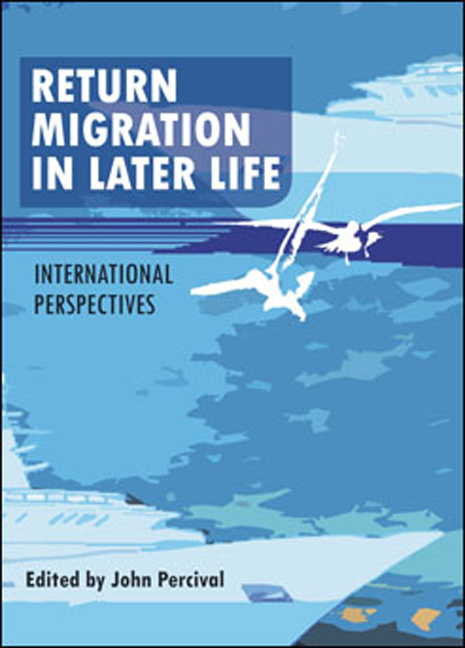Book contents
- Frontmatter
- Contents
- List of tables and figures
- Notes on contributors
- Acknowledgements
- one Charting the waters: return migration in later life
- two Older immigrants leaving Sweden
- three Place and residence attachments in Canada’s older population
- four Ageing immigrants and the question of return: new answers to an old dilemma?
- five Caribbean return migration in later life: family issues and transnational experiences as influential pre-retirement factors
- six ‘We belong to the land’: British immigrants in Australia contemplating or realising their return ‘home’ in later life
- seven Diasporic returns to the city: Anglo-Indian and Jewish visits to Calcutta in later life
- eight Returning to ‘roots’: Estonian-Australian child migrants visiting the homeland
- nine Ageing in the ancestral homeland: ethno-biographical reflections on return migration in later life
- ten ‘The past is a foreign country’: vulnerability to mental illness among return migrants
- eleven The blues of the ageing retornados: narratives on the return to Chile
- twelve Concluding reflections
- Endnotes
- Index
eight - Returning to ‘roots’: Estonian-Australian child migrants visiting the homeland
Published online by Cambridge University Press: 01 February 2022
- Frontmatter
- Contents
- List of tables and figures
- Notes on contributors
- Acknowledgements
- one Charting the waters: return migration in later life
- two Older immigrants leaving Sweden
- three Place and residence attachments in Canada’s older population
- four Ageing immigrants and the question of return: new answers to an old dilemma?
- five Caribbean return migration in later life: family issues and transnational experiences as influential pre-retirement factors
- six ‘We belong to the land’: British immigrants in Australia contemplating or realising their return ‘home’ in later life
- seven Diasporic returns to the city: Anglo-Indian and Jewish visits to Calcutta in later life
- eight Returning to ‘roots’: Estonian-Australian child migrants visiting the homeland
- nine Ageing in the ancestral homeland: ethno-biographical reflections on return migration in later life
- ten ‘The past is a foreign country’: vulnerability to mental illness among return migrants
- eleven The blues of the ageing retornados: narratives on the return to Chile
- twelve Concluding reflections
- Endnotes
- Index
Summary
Introduction
As we have seen in previous chapters, ageing migrants can yearn to go back to their homeland. In many cases, having been separated by large physical distances and periods of time, this feeling tends to grow stronger and stronger (Baldassar, 2001). Some eventually move back to the homeland but the large majority do not. Rather, they engage with its emotional pull by making return visits, journeying back and forth between their country of birth and country of residence (Baldassar, 2001; Stephenson, 2002; Coles and Timothy, 2004). These trips are an important way of maintaining connections to the homeland, and building new ones.
This chapter explores the role of homeland visits for Estonians that migrated to Australia as children and are now around retirement age. There was a large wave of emigration from Estonia during the Second World War and many of those who left settled in Australia (Tammaru et al, 2010). Cut off from their homeland, which had become incorporated into the Soviet Union, they made new lives and many became, to a large degree, Australian. A significant number of them migrated as children and have lived most of their lives in Australia (Salasoo, 1986). But in the early 1990s, the situation changed. Estonia regained independence and many of these child migrants found it possible to visit Estonia. They went to seek out long-lost relatives and return to their ‘roots’, and even to form new relationships with Estonia, while maintaining their lives and family relationships in Australia. This chapter examines their experiences: Why did they visit Estonia? Why do they keep going back? How do these visits affect their identities and their lives?
The history
Estonia is a small country of around 1.3 million people in north-east Europe. In 1940, during the Second World War, it became absorbed into the Soviet Union and remained under the ‘Iron Curtain’ until regaining independence in 1991. Around this time, fear of repression, persecution or deportation to Siberia by Soviet authorities led to large-scale involuntary emigration, with thousands of Estonians fleeing to the West. Many lived temporarily in displaced persons camps in Germany and Sweden before ending up in the United States, Canada, Britain, Australia and elsewhere (Tammaru et al, 2010). After the war, around 6,000 Estonians resettled in Australia (Tammaru et al, 2010), mainly in Sydney, Melbourne and Adelaide.
- Type
- Chapter
- Information
- Return Migration in Later LifeInternational Perspectives, pp. 161 - 178Publisher: Bristol University PressPrint publication year: 2013



